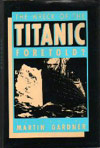 |
Gardner, Martin (editor). Wreck of the Titanic Foretold?. 1st printing. Buffalo: Prometheus. 1986. hardcover. isbn: 0879753218. scarcity: hard to find.
Before the Titanic disaster changed how the world looked at steamship travel, there were authors writing fictional accounts about the loss of a great liner due to collision with an iceberg. Were these authors merely keen observers of the potential dangers to the ocean liner trade during their time? Or did they have psychic gifts that enabled them to predict an event that most people, laymen and expert alike, would have considered to be highly improbable, if not outright impossible.
In this book the author, a well known skeptic of the paranormal, argues that these fictional foretellings of a Titanic-like wreck were no more than statistical coincidence. He opens the book with a lengthy introduction wherein he attempts to establish how easy it is to find coincidences in seemingly random events. He also discusses in some detail the problems often associated with paranormal research, which may be very eye opening to a lot of readers who might ordinarily take these types of stories at face value.
Gardner discusses three works of fiction that predicted a disaster similar to that of the Titanic. He prefaces each story with an introduction and discussion. He starts with what must surely be history’s most prominent fictional foretelling, Morgan Robertson’s 1898 novella Futility, of which most readers browsing this site will probably be familiar.
For those of you who are not, Robertson wrote of a British ocean liner, 800 feet long, with triple expansion engines, two masts and three screws. This fictional ship was the largest most luxurious ever built and was considered unsinkable. She was racing across the Atlantic in the month of April at high speed when she collided with an iceberg off the Grand Banks of Newfoundland near midnight. Despite her many watertight compartments, the ship foundered very quickly and almost everyone was lost, due in no small part to a completely insufficient number of lifeboats. The name of Robertson’s fictional ship was the Titan.
If you haven’t read it before, Robertson’s novella is reproduced in its entirety in this book. There were actually two versions of Futility, the original 1898 story, and a slightly altered rewrite for the more common 1912 edition in which the title was upgraded to Futility, or The Wreck of the Titan. Gardner chose to reprint the latter version, but he does discuss at some length both versions, and how they differ. Not that the differences are significant, because they are not. Still it is interesting to see how the story was altered.
Many writers have compared the similarities between the fictional wreck and the real disaster, but Gardner is the first to go on and contrast the differences between the two events as well. The Titan was filled to capacity, for example, while the Titanic was barely half full. Titanic’s last night was clear and cloud free, the Titan was racing through heavy fog. The survival rate between the two is also very different. On Titanic, roughly a third of the people survived, while the Titan went down with just about everyone aboard, there were only thirteen survivors.
Oddly enough though, the author misses the single most striking difference between the two events. In Robertson’s story, the Titan does not sideswipe a berg, the ship actually steams right up onto an upward sloping ice shelf. The Titan then tips over onto its starboard side and slides back into the ocean, where it quickly floods and sinks.
Gardner next discusses William Stead’s story From the Old World to the New. This fictional work, Stead’s first novel, is an unusual combination of spiritualism, a love story, and tour of the upcoming Chicago World’s Fair of 1893! Though it is only a brief aside to the main plot, Stead includes an account of the loss of a liner to ice within this story.
The Titanic connection is particularly striking because Stead has the real White Star liner Majestic, under the command of none other than Captain E.J. Smith, rescuing the survivors from a liner lost in collision with an iceberg. From the Old World to the New was originally published as the Christmas issue of Stead’s magazine, The Review of Reviews, in December 1892. Gardner includes the portions of the two relevant chapters from Stead’s work.
Stead was himself an avid spiritualist who believed he could “ghost write” the thoughts of people over great distances, not to mention the ability to read the thoughts of the dead. Sort of like psychic Morse code. Unfortunately, Stead was not psychic enough to foretell his own fate. He sailed on Titanic’s maiden voyage and was lost with the ship.
Gardner covers a third short story with the same theme, and again with many similarities to the Titanic event. This one was first printed the closest in time to when the real wreck happened so I am amazed the story has received so little attention in the Titanic cannon. Until reading Gardner’s book I had not been aware of it at all. The story is The White Ghost of Disaster by Mayn Clew Garnett. It was published in May of 1912, but was already at the printers in April when the Titanic sank. The complete short story is included in full.
Finally, the author includes a few short poems with a similar motif, including Celia Thaxter’s 1870’s poem, A Tryst. Through his examination of these works. the author makes a strong case that rather than being prophetic, the fear of the loss of a great liner was on the minds of many people during the closing decades of the 19th century.
There was apparently a softcover edition by Prometheus Books in 1986 as well.
|